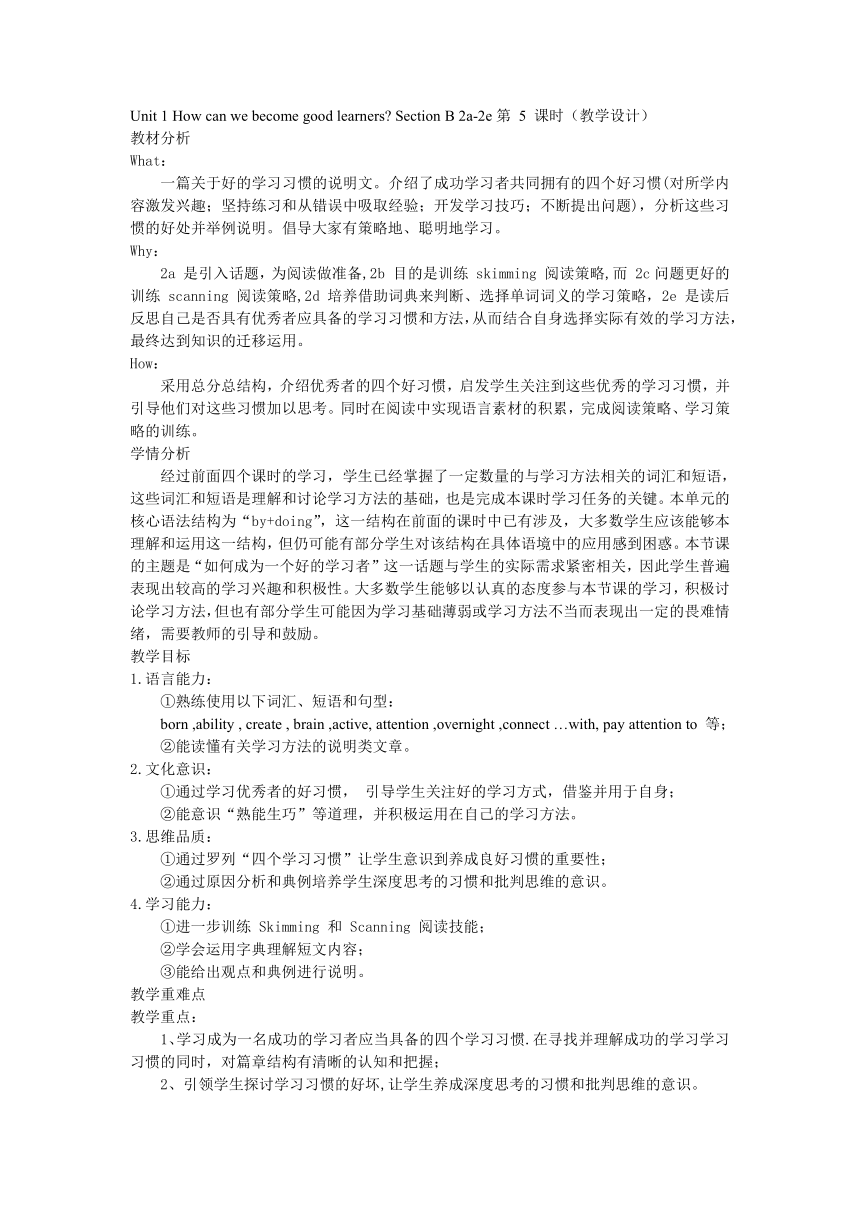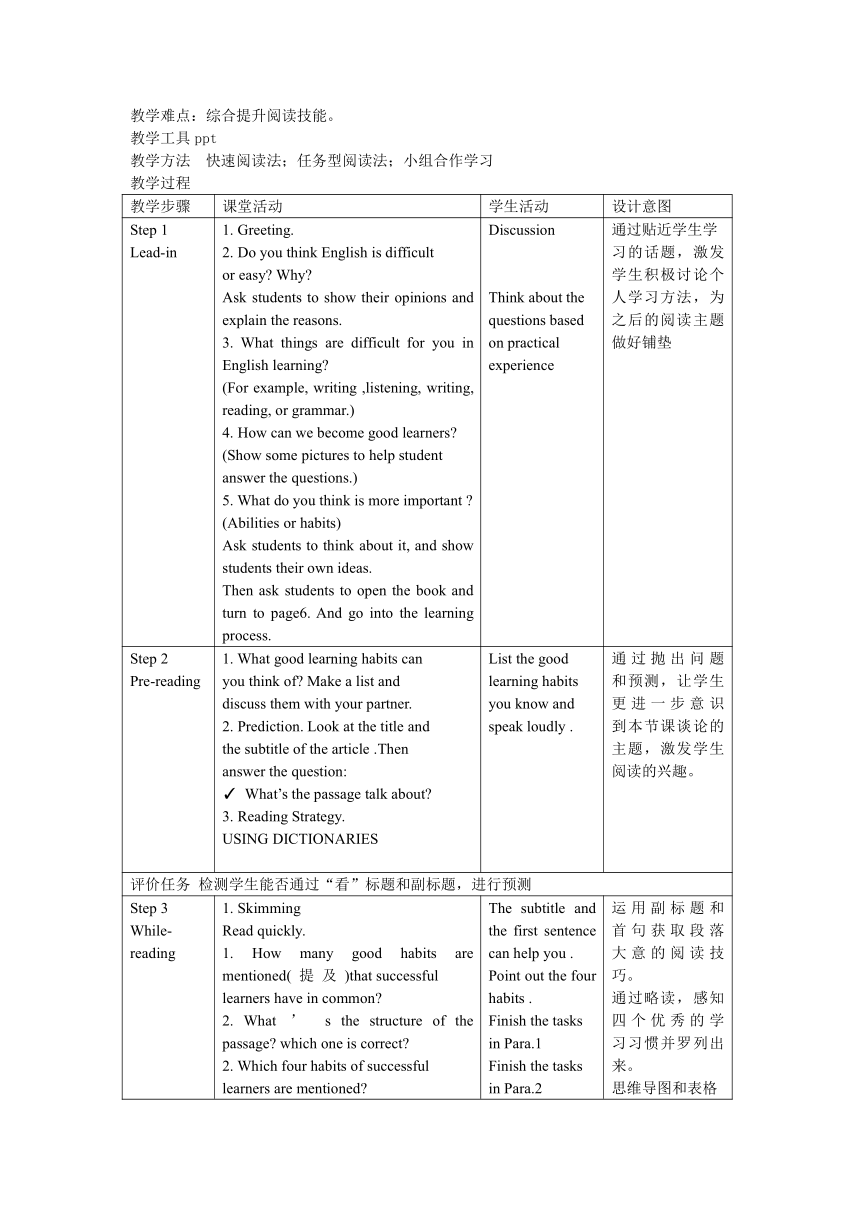Unit 1 How can we become good learners Section B 2a-2e教学设计(表格式) 人教版九年级全册
文档属性
| 名称 | Unit 1 How can we become good learners Section B 2a-2e教学设计(表格式) 人教版九年级全册 |  | |
| 格式 | docx | ||
| 文件大小 | 334.7KB | ||
| 资源类型 | 教案 | ||
| 版本资源 | 人教新目标(Go for it)版 | ||
| 科目 | 英语 | ||
| 更新时间 | 2024-12-03 14:43:44 | ||
图片预览


文档简介
Unit 1 How can we become good learners Section B 2a-2e第 5 课时(教学设计)
教材分析
What:
一篇关于好的学习习惯的说明文。介绍了成功学习者共同拥有的四个好习惯(对所学内容激发兴趣;坚持练习和从错误中吸取经验;开发学习技巧;不断提出问题),分析这些习惯的好处并举例说明。倡导大家有策略地、聪明地学习。
Why:
2a 是引入话题,为阅读做准备,2b 目的是训练 skimming 阅读策略,而 2c问题更好的训练 scanning 阅读策略,2d 培养借助词典来判断、选择单词词义的学习策略,2e 是读后反思自己是否具有优秀者应具备的学习习惯和方法,从而结合自身选择实际有效的学习方法,最终达到知识的迁移运用。
How:
采用总分总结构,介绍优秀者的四个好习惯,启发学生关注到这些优秀的学习习惯,并引导他们对这些习惯加以思考。同时在阅读中实现语言素材的积累,完成阅读策略、学习策略的训练。
学情分析
经过前面四个课时的学习,学生已经掌握了一定数量的与学习方法相关的词汇和短语,这些词汇和短语是理解和讨论学习方法的基础,也是完成本课时学习任务的关键。本单元的核心语法结构为“by+doing”,这一结构在前面的课时中已有涉及,大多数学生应该能够本理解和运用这一结构,但仍可能有部分学生对该结构在具体语境中的应用感到困惑。本节课的主题是“如何成为一个好的学习者”这一话题与学生的实际需求紧密相关,因此学生普遍表现出较高的学习兴趣和积极性。大多数学生能够以认真的态度参与本节课的学习,积极讨论学习方法,但也有部分学生可能因为学习基础薄弱或学习方法不当而表现出一定的畏难情
绪,需要教师的引导和鼓励。
教学目标
1.语言能力:
①熟练使用以下词汇、短语和句型:
born ,ability , create , brain ,active, attention ,overnight ,connect …with, pay attention to 等;
②能读懂有关学习方法的说明类文章。
2.文化意识:
①通过学习优秀者的好习惯, 引导学生关注好的学习方式,借鉴并用于自身;
②能意识“熟能生巧”等道理,并积极运用在自己的学习方法。
3.思维品质:
①通过罗列“四个学习习惯”让学生意识到养成良好习惯的重要性;
②通过原因分析和典例培养学生深度思考的习惯和批判思维的意识。
4.学习能力:
①进一步训练 Skimming 和 Scanning 阅读技能;
②学会运用字典理解短文内容;
③能给出观点和典例进行说明。
教学重难点
教学重点:
1、学习成为一名成功的学习者应当具备的四个学习习惯.在寻找并理解成功的学习学习习惯的同时,对篇章结构有清晰的认知和把握;
2、引领学生探讨学习习惯的好坏,让学生养成深度思考的习惯和批判思维的意识。
教学难点:综合提升阅读技能。
教学工具ppt
教学方法 快速阅读法;任务型阅读法;小组合作学习
教学过程
教学步骤 课堂活动 学生活动 设计意图
Step 1 Lead-in 1. Greeting. 2. Do you think English is difficult or easy Why Ask students to show their opinions and explain the reasons. 3. What things are difficult for you in English learning (For example, writing ,listening, writing, reading, or grammar.) 4. How can we become good learners (Show some pictures to help student answer the questions.) 5. What do you think is more important (Abilities or habits) Ask students to think about it, and show students their own ideas. Then ask students to open the book and turn to page6. And go into the learning process. Discussion Think about the questions based on practical experience 通过贴近学生学 习的话题,激发学生积极讨论个人学习方法,为之后的阅读主题做好铺垫
Step 2 Pre-reading 1. What good learning habits can you think of Make a list and discuss them with your partner. 2. Prediction. Look at the title and the subtitle of the article .Then answer the question: What’s the passage talk about 3. Reading Strategy. USING DICTIONARIES List the good learning habits you know and speak loudly . 通过抛出问题 和预测,让学生更进一步意识 到本节课谈论的主题,激发学生 阅读的兴趣。
评价任务 检测学生能否通过“看”标题和副标题,进行预测
Step 3 While- reading 1. Skimming Read quickly. 1. How many good habits are mentioned( 提 及 )that successful learners have in common 2. What ’ s the structure of the passage which one is correct 2. Which four habits of successful learners are mentioned 3. Scanning. Read Para.1 and answer the following questions 1. Does the writer think that everyone is born with the ability to learn well Do you agree with the writer’s opinions Why 4.Read Para.2 and finish the mindmap. 5.What do we need to do after we have an interest in it? Read Para.3 and answer the questions. 1.What do good learners think about 2.Find out the sayings 3.How did Bell succeed in inventing the telephone Read Para.4 and finish the mind map by reading their notes every day by explaining the information to another student. 6. Do you think it’s important to ask questions? Read Para.5 and finish the mind map. 7. Read Para.6 and answer the questions. 8.Read the passage again and answer the questions The subtitle and the first sentence can help you . Point out the four habits . Finish the tasks in Para.1 Finish the tasks in Para.2 Finish the tasks in Para.3 Finish the tasks in Para.4 Finish the tasks in Para.5 Work on 2c 运用副标题和 首句获取段落 大意的阅读技巧。 通过略读,感知四个优秀的学 习习惯并罗列出来。 思维导图和表格 任务有助于学生 更好地理解文章 架构和要点。 用提问题的方 式衔接下一个 环节的话题。引导学生更好的 感知文章架构和思想,一步步进行深入思考、探 究每个话题的内容。 帮助学生通过 阅读、回答问题,掌握文章内容,同时掌握阅读技巧
评价任务 学生是否能在略读过程中,正确地寻找到相关信息,感知到篇章的整体布局;能否在细读过程中,提取主干信息的能力;是否随着问题的层层递进,对文章有更深层的阅读感知;能否通过不断的思考,锻炼学生的思维能力。
Step 4 Post-reading 1. Retell. 2. Make a mind map . 3. Let’s talk. How to write an exposition(说明文) 4. Look up the following words from the passage in the dictionary. Then write a sentence for each word. 5. Discussion. What learning habits do you think are useful Fill in the blanks. Retell the article by using the mind map. Refine. Work on 2d. Work on 2e 检测学生对文 章大意及重点 词汇和语句的理解。丰富学生写作内容,为下节课的写作奠定了良好的基础。 锻炼查字典的 能力
评价任务 学生是否积极参与读后讨论,能否根据文章信息正确使用目标语言进行大意梳理陈述;能否使用新学知识进行知识迁移
Step 5 Language Points Explain some knowledge points. Get to the important language points in this class 将本节重点汇总系统讲解和分析,帮助学生学习知识点。
Step 6 Summary Ask Ss to work together and summarize what they have learned in this class. Work in groups and summarize what we have learned. 总结本课所学 内容,利用将思维导图给学生 进行有序的梳理。
Step 8 Homework Level B: Use dictionaries to look up the new words in 2d Level A: Check the website for some other good learning habits and share them with your partners Write down. 巩固课堂效果。
教材分析
What:
一篇关于好的学习习惯的说明文。介绍了成功学习者共同拥有的四个好习惯(对所学内容激发兴趣;坚持练习和从错误中吸取经验;开发学习技巧;不断提出问题),分析这些习惯的好处并举例说明。倡导大家有策略地、聪明地学习。
Why:
2a 是引入话题,为阅读做准备,2b 目的是训练 skimming 阅读策略,而 2c问题更好的训练 scanning 阅读策略,2d 培养借助词典来判断、选择单词词义的学习策略,2e 是读后反思自己是否具有优秀者应具备的学习习惯和方法,从而结合自身选择实际有效的学习方法,最终达到知识的迁移运用。
How:
采用总分总结构,介绍优秀者的四个好习惯,启发学生关注到这些优秀的学习习惯,并引导他们对这些习惯加以思考。同时在阅读中实现语言素材的积累,完成阅读策略、学习策略的训练。
学情分析
经过前面四个课时的学习,学生已经掌握了一定数量的与学习方法相关的词汇和短语,这些词汇和短语是理解和讨论学习方法的基础,也是完成本课时学习任务的关键。本单元的核心语法结构为“by+doing”,这一结构在前面的课时中已有涉及,大多数学生应该能够本理解和运用这一结构,但仍可能有部分学生对该结构在具体语境中的应用感到困惑。本节课的主题是“如何成为一个好的学习者”这一话题与学生的实际需求紧密相关,因此学生普遍表现出较高的学习兴趣和积极性。大多数学生能够以认真的态度参与本节课的学习,积极讨论学习方法,但也有部分学生可能因为学习基础薄弱或学习方法不当而表现出一定的畏难情
绪,需要教师的引导和鼓励。
教学目标
1.语言能力:
①熟练使用以下词汇、短语和句型:
born ,ability , create , brain ,active, attention ,overnight ,connect …with, pay attention to 等;
②能读懂有关学习方法的说明类文章。
2.文化意识:
①通过学习优秀者的好习惯, 引导学生关注好的学习方式,借鉴并用于自身;
②能意识“熟能生巧”等道理,并积极运用在自己的学习方法。
3.思维品质:
①通过罗列“四个学习习惯”让学生意识到养成良好习惯的重要性;
②通过原因分析和典例培养学生深度思考的习惯和批判思维的意识。
4.学习能力:
①进一步训练 Skimming 和 Scanning 阅读技能;
②学会运用字典理解短文内容;
③能给出观点和典例进行说明。
教学重难点
教学重点:
1、学习成为一名成功的学习者应当具备的四个学习习惯.在寻找并理解成功的学习学习习惯的同时,对篇章结构有清晰的认知和把握;
2、引领学生探讨学习习惯的好坏,让学生养成深度思考的习惯和批判思维的意识。
教学难点:综合提升阅读技能。
教学工具ppt
教学方法 快速阅读法;任务型阅读法;小组合作学习
教学过程
教学步骤 课堂活动 学生活动 设计意图
Step 1 Lead-in 1. Greeting. 2. Do you think English is difficult or easy Why Ask students to show their opinions and explain the reasons. 3. What things are difficult for you in English learning (For example, writing ,listening, writing, reading, or grammar.) 4. How can we become good learners (Show some pictures to help student answer the questions.) 5. What do you think is more important (Abilities or habits) Ask students to think about it, and show students their own ideas. Then ask students to open the book and turn to page6. And go into the learning process. Discussion Think about the questions based on practical experience 通过贴近学生学 习的话题,激发学生积极讨论个人学习方法,为之后的阅读主题做好铺垫
Step 2 Pre-reading 1. What good learning habits can you think of Make a list and discuss them with your partner. 2. Prediction. Look at the title and the subtitle of the article .Then answer the question: What’s the passage talk about 3. Reading Strategy. USING DICTIONARIES List the good learning habits you know and speak loudly . 通过抛出问题 和预测,让学生更进一步意识 到本节课谈论的主题,激发学生 阅读的兴趣。
评价任务 检测学生能否通过“看”标题和副标题,进行预测
Step 3 While- reading 1. Skimming Read quickly. 1. How many good habits are mentioned( 提 及 )that successful learners have in common 2. What ’ s the structure of the passage which one is correct 2. Which four habits of successful learners are mentioned 3. Scanning. Read Para.1 and answer the following questions 1. Does the writer think that everyone is born with the ability to learn well Do you agree with the writer’s opinions Why 4.Read Para.2 and finish the mindmap. 5.What do we need to do after we have an interest in it? Read Para.3 and answer the questions. 1.What do good learners think about 2.Find out the sayings 3.How did Bell succeed in inventing the telephone Read Para.4 and finish the mind map by reading their notes every day by explaining the information to another student. 6. Do you think it’s important to ask questions? Read Para.5 and finish the mind map. 7. Read Para.6 and answer the questions. 8.Read the passage again and answer the questions The subtitle and the first sentence can help you . Point out the four habits . Finish the tasks in Para.1 Finish the tasks in Para.2 Finish the tasks in Para.3 Finish the tasks in Para.4 Finish the tasks in Para.5 Work on 2c 运用副标题和 首句获取段落 大意的阅读技巧。 通过略读,感知四个优秀的学 习习惯并罗列出来。 思维导图和表格 任务有助于学生 更好地理解文章 架构和要点。 用提问题的方 式衔接下一个 环节的话题。引导学生更好的 感知文章架构和思想,一步步进行深入思考、探 究每个话题的内容。 帮助学生通过 阅读、回答问题,掌握文章内容,同时掌握阅读技巧
评价任务 学生是否能在略读过程中,正确地寻找到相关信息,感知到篇章的整体布局;能否在细读过程中,提取主干信息的能力;是否随着问题的层层递进,对文章有更深层的阅读感知;能否通过不断的思考,锻炼学生的思维能力。
Step 4 Post-reading 1. Retell. 2. Make a mind map . 3. Let’s talk. How to write an exposition(说明文) 4. Look up the following words from the passage in the dictionary. Then write a sentence for each word. 5. Discussion. What learning habits do you think are useful Fill in the blanks. Retell the article by using the mind map. Refine. Work on 2d. Work on 2e 检测学生对文 章大意及重点 词汇和语句的理解。丰富学生写作内容,为下节课的写作奠定了良好的基础。 锻炼查字典的 能力
评价任务 学生是否积极参与读后讨论,能否根据文章信息正确使用目标语言进行大意梳理陈述;能否使用新学知识进行知识迁移
Step 5 Language Points Explain some knowledge points. Get to the important language points in this class 将本节重点汇总系统讲解和分析,帮助学生学习知识点。
Step 6 Summary Ask Ss to work together and summarize what they have learned in this class. Work in groups and summarize what we have learned. 总结本课所学 内容,利用将思维导图给学生 进行有序的梳理。
Step 8 Homework Level B: Use dictionaries to look up the new words in 2d Level A: Check the website for some other good learning habits and share them with your partners Write down. 巩固课堂效果。
同课章节目录
- Unit 1 How can we become good learners.
- Section A
- Section B
- Unit 2 I think that mooncakes are delicious!
- Section A
- Section B
- Unit 3 Could you please tell me where the restroom
- Section A
- Section B
- Unit 4 I used to be afraid of the dark.
- Section A
- Section B
- Unit 5 What are the shirts made of?
- Section A
- Section B
- Review of Units 1-5
- Unit 6 When was it invented?
- Section A
- Section B
- Unit 7 Teenagers should be allowed to choose their
- Section A
- Section B
- Unit 8 It must belong to Carla.
- Section A
- Section B
- Unit 9 I like music that I can dance to.
- Section A
- Section B
- Unit 10 You're supposed to shake hands.
- Section A
- Section B
- Review of Units 6-10
- Unit 11 Sad movies make me cry.
- Section A
- Section B
- Unit 12 Life is full of the unexpected
- Section A
- Section B
- Unit 13 We're trying to save the earth!
- Section A
- Section B
- Unit 14 I remember meeting all of you in Grade 7.
- Section A
- Section B
- Review of Units 11-14
